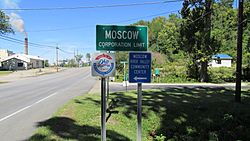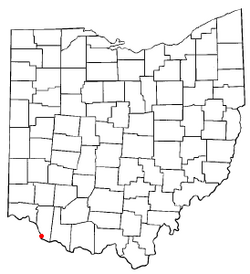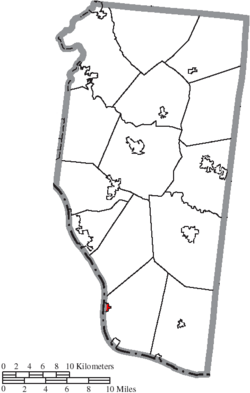Moscow, Ohio facts for kids
Quick facts for kids
Moscow, Ohio
|
|
|---|---|
|
Village
|
|

Moscow corporation limit sign with William H. Zimmer Power Station in the background.
|
|
| Motto(s):
"...a peaceful spot on the River"
|
|

Location of Moscow, Ohio
|
|

Location of Moscow in Clermont County
|
|
| Country | United States |
| State | Ohio |
| County | Clermont |
| Township | Washington |
| Area | |
| • Total | 0.39 sq mi (1.01 km2) |
| • Land | 0.37 sq mi (0.95 km2) |
| • Water | 0.02 sq mi (0.06 km2) |
| Elevation | 499 ft (152 m) |
| Population
(2020)
|
|
| • Total | 155 |
| • Density | 422.34/sq mi (163.12/km2) |
| Time zone | UTC-5 (Eastern (EST)) |
| • Summer (DST) | UTC-4 (EDT) |
| ZIP code |
45153
|
| Area code(s) | 513 |
| FIPS code | 39-52416 |
| GNIS feature ID | 2399404 |
Moscow (pronounced MOS-koh) is a small village located in Clermont County, Ohio. In 2020, about 155 people lived there. A large power plant called the William H. Zimmer Power Station is partly located within the village. This plant was originally planned to be a nuclear power plant, but it was later changed to use coal. Moscow is also close to the birthplace of Ulysses S. Grant, who became a famous general and U.S. President.
Contents
History of Moscow, Ohio
Moscow was officially planned and laid out in 1816. Some people believe the town got its name from French immigrants. These immigrants might have been soldiers who fought with Napoleon in the Battle of Borodino near Moscow, Russia. A post office has been open in Moscow, Ohio, since 1826.
Famous People from Moscow
William J. Bulow, who was born in Moscow in 1869, became a very important person. He served as a U.S. Senator for South Dakota and also as the Governor of South Dakota. He went to school right there in Moscow.
Tornado Event in 2012
On March 2, 2012, a powerful tornado hit Moscow. This tornado was part of a larger storm system that affected Indiana, Kentucky, and Ohio. The tornado caused a lot of damage, destroying more than 80% of the buildings in the town. Sadly, some people lost their lives during this event.
Geography of Moscow, Ohio
Moscow is located right along the Ohio River, which is a major river in the United States.
The United States Census Bureau measures the size of towns. Moscow covers a total area of about 0.39 square miles (1.01 square kilometers). Most of this area, about 0.37 square miles (0.95 square kilometers), is land. The rest, about 0.02 square miles (0.06 square kilometers), is water, likely from the Ohio River.
Population Changes in Moscow
| Historical population | |||
|---|---|---|---|
| Census | Pop. | %± | |
| 1860 | 434 | — | |
| 1870 | 443 | 2.1% | |
| 1880 | 516 | 16.5% | |
| 1890 | 591 | 14.5% | |
| 1900 | 475 | −19.6% | |
| 1910 | 327 | −31.2% | |
| 1920 | 274 | −16.2% | |
| 1930 | 293 | 6.9% | |
| 1940 | 309 | 5.5% | |
| 1950 | 336 | 8.7% | |
| 1960 | 438 | 30.4% | |
| 1970 | 348 | −20.5% | |
| 1980 | 324 | −6.9% | |
| 1990 | 279 | −13.9% | |
| 2000 | 244 | −12.5% | |
| 2010 | 185 | −24.2% | |
| 2020 | 155 | −16.2% | |
| U.S. Decennial Census | |||
What the 2010 Census Showed
In 2010, the census counted 185 people living in Moscow. These people lived in 81 different homes. About 51 of these homes were families.
The population density was about 500 people per square mile (193 people per square kilometer). This means that for every square mile of land, there were about 500 people. There were 96 housing units in total.
Most of the people in the village (98.4%) were White. A small number (1.1%) were African American, and 0.5% were from other backgrounds. About 1.6% of the population identified as Hispanic or Latino.
About a quarter of the homes (24.7%) had children under 18 living there. Many homes (44.4%) were married couples living together. The average number of people in each home was about 2.28.
The average age of people in Moscow was 47.7 years old. About 16.8% of the residents were under 18. Most people were between 45 and 64 years old (39.9%). The village had slightly more males (51.9%) than females (48.1%).
See also
 In Spanish: Moscow (Ohio) para niños
In Spanish: Moscow (Ohio) para niños

